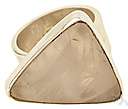am·ber
(ăm′bər)n.
1. A hard, translucent, usually brownish-yellow fossil resin, used for making jewelry and other ornamental objects.
2. A brownish yellow.
adj.
1. Having the color of amber; brownish-yellow.
2. Made of or resembling amber: an amber necklace.
[Middle English ambre, from Old French, from Medieval Latin ambra, ambar, from Arabic 'anbar, ambergris, amber.]
American Heritage® Dictionary of the English Language, Fifth Edition. Copyright © 2016 by Houghton Mifflin Harcourt Publishing Company. Published by Houghton Mifflin Harcourt Publishing Company. All rights reserved.
amber
(ˈæmbə)n
1. (Elements & Compounds)
a. a yellow or yellowish-brown hard translucent fossil resin derived from extinct coniferous trees that occurs in Tertiary deposits and often contains trapped insects. It is used for jewellery, ornaments, etc
b. (as modifier): an amber necklace. succinic
2. fly in amber a strange relic or reminder of the past
3. (Colours)
a. a medium to dark brownish-yellow colour, often somewhat orange, similar to that of the resin
b. (as adjective): an amber dress.
4. an amber traffic light used as a warning between red and green
[C14: from Medieval Latin ambar, from Arabic `anbar ambergris]
Collins English Dictionary – Complete and Unabridged, 12th Edition 2014 © HarperCollins Publishers 1991, 1994, 1998, 2000, 2003, 2006, 2007, 2009, 2011, 2014
am•ber
(ˈæm bər)n.
1. a yellow, red, or brown translucent fossil resin of coniferous trees that becomes charged with static electricity when rubbed: used for jewelry.
2. the yellowish brown color of amber.
adj. 3. yellowish brown.
4. made of amber.
[1350–1400; Middle English ambre < Old French < Medieval Latin ambra < Arabic ‘anbar ambergris]
Random House Kernerman Webster's College Dictionary, © 2010 K Dictionaries Ltd. Copyright 2005, 1997, 1991 by Random House, Inc. All rights reserved.
am·ber
(ăm′bər) A hard, translucent, brownish-yellow substance that is the fossilized resin of ancient trees. It often contains fossil insects.
Did You Know? The plot of the movie Jurassic Park turns on the extraordinary ability of amber to preserve ancient life as miniature fossils. In the movie, scientists extract dinosaur DNA from blood in the stomach of a mosquito that was trapped in amber during the Mesozoic Era. The scientists then use the DNA to create clones of the dinosaurs that end up terrorizing the park and the movie audience. What is amber, and how does it preserve such delicate tissues for millions of years? Certain trees, especially conifers, produce a sticky substance called resin to protect themselves against insects. Normally, it decays in oxygen through the action of bacteria. However, if the resin happens to fall into wet mud or sand containing little oxygen, it can harden and eventually fossilize, becoming the yellowish, translucent substance known as amber. If any insects or other organisms are trapped in the resin before it hardens, they can be preserved, often in amazing detail. While amber may sometimes preserve fragments of the DNA of the enclosed organisms, fossil mosquitoes would not contain enough dinosaur DNA to actually create clones, and the sight of dinosaurs again roaming the Earth, even in an island park, remains part of science fiction rather than real science.
The American Heritage® Student Science Dictionary, Second Edition. Copyright © 2014 by Houghton Mifflin Harcourt Publishing Company. Published by Houghton Mifflin Harcourt Publishing Company. All rights reserved.
ThesaurusAntonymsRelated WordsSynonymsLegend:
| Noun | 1. |  amber - a deep yellow color; "an amber light illuminated the room"; "he admired the gold of her hair" amber - a deep yellow color; "an amber light illuminated the room"; "he admired the gold of her hair"yellow, yellowness - yellow color or pigment; the chromatic color resembling the hue of sunflowers or ripe lemons |
| 2. |  amber - a hard yellowish to brownish translucent fossil resin; used for jewelry amber - a hard yellowish to brownish translucent fossil resin; used for jewelrynatural resin - a plant exudate | |
| Adj. | 1. | amber - of a medium to dark brownish yellow color chromatic - being or having or characterized by hue |
Based on WordNet 3.0, Farlex clipart collection. © 2003-2012 Princeton University, Farlex Inc.
amber
nounRelated words
adjective succinic
adjective succinic
Collins Thesaurus of the English Language – Complete and Unabridged 2nd Edition. 2002 © HarperCollins Publishers 1995, 2002
Translations
كَهْرَمانكَهْرَمَان
jantarjantarový
rav
merevaik
meripihkakeltainen
jantar
borostyánborostyánkõ
raf
琥珀色
호박(광물)
gintaras
dzintara-dzintars
jantárjantárový
jantar
jantar
bärnstengul
อำพัน
hổ phách
amber
[ˈæmbəʳ]Collins Spanish Dictionary - Complete and Unabridged 8th Edition 2005 © William Collins Sons & Co. Ltd. 1971, 1988 © HarperCollins Publishers 1992, 1993, 1996, 1997, 2000, 2003, 2005
amber
[ˈæmbər] modif (= made of amber) [bead, necklace] → d'ambre
Collins English/French Electronic Resource. © HarperCollins Publishers 2005
amber
adj → aus Bernstein; (= amber-coloured) → bernsteinfarben; (Brit) traffic light → gelb; the amber nectar (Brit, Austral: inf) → das kühle Nass (inf), → der Gerstensaft (hum)
Collins German Dictionary – Complete and Unabridged 7th Edition 2005. © William Collins Sons & Co. Ltd. 1980 © HarperCollins Publishers 1991, 1997, 1999, 2004, 2005, 2007
Collins Italian Dictionary 1st Edition © HarperCollins Publishers 1995
amber
(ˈӕmbə) noun, adjective (of) a hard yellow or brownish substance, formed from resin, used in making jewellery etc. made of amber; an amber brooch.
Kernerman English Multilingual Dictionary © 2006-2013 K Dictionaries Ltd.
amber
→ كَهْرَمان jantar rav Bernstein κεχριμπάρι ámbar meripihka ambre jantar ambra 琥珀色 호박(광물) amber ravgul bursztyn âmbar янтарь bärnsten อำพัน kehribar hổ phách 琥珀Multilingual Translator © HarperCollins Publishers 2009
am·ber
n. ámbar;
a. ambarino-a.
English-Spanish Medical Dictionary © Farlex 2012

